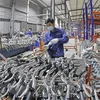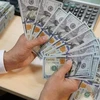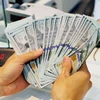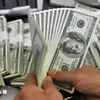The VND-USD exchange rate is expected to remain stable from now to the end of this year and the tendency will move on during the 2014-2015 period.
Le Quang Trung, deputy general director and head of treasury of Vietnam International Bank (VIB), said that the rate would hover around 21,300-21,500 VND to the dollar in the last quarter and enterprises should take full advantage of the forex stability to reduce the capital cost. The Saigon Times Daily talked with Trung over the issue. Excerpts:
* What is the foundation for your prediction?
There are several factors that support the forex rate stability such as a low trade deficit at around 600 million USD in the January-August period, and the trade deficit is expected at around 3 percent of export revenue (around 3-4 billion USD) for 2013. Foreign reserves remain high, at 27 billion USD, while foreign direct investment (FDI) disbursement and overseas remittance remain stable.
The ‘hot’ money flow into Vietnam is not huge, accounting for around 1 percent of the total inflows in Asian emerging markets. If the capital is withdrawn, it will cause impacts on the forex rate in the short term but the impacts are not strong. In addition, Circular 37/2012/TT-NHNN has sharply reduced the number of dollar borrowers.
Concerning the factors that may put pressure on the exchange rate, the demand for the dollar often runs high towards the end of the year for settlements of import payments. In addition, the State Bank of Vietnam must continue to import gold for domestic sales.
* Does it mean that enterprises with foreign currency demands can set their mind at rest?
Yes. This is a favourable chance for enterprises to take advantage of exchange rate stability and optimise financial and capital expenses and improve profits.
* What can enterprises do to take advantage of the exchange rate stability?
Enterprises should pay attention to exchange rate risk insurance solutions such as Traditional FX Forward, Par Forward, Forward with FX order, FX with Deposit and Participating forward. There are also solutions to optimise the conversion of foreign currencies into VND, such as currency and interest rate swaps. The solutions are applied flexibly at various points of time depending on the exchange rate, capital flows of enterprises and order terms. For foreign currencies other than the USD, enterprises need consulting on the transaction time by comparing fluctuations of the exchange rate of the currency and the dollar. Notably, VIB does not charge any fees on these services.
* What do you comment on the foreign currency demand of local enterprises over the past year?
Outstanding foreign currency loans in the banking system have declined 11 percent against late 2012, meaning that the demand has decreased sharply due to Circular 37. Secondly, the market has offered many flexible instruments for enterprises to choose from, instead of directly taking out foreign currency loans.
* But the stability has resulted from sluggish business operations and the weak economy. What should be done to give back strength to enterprises?
In previous years, we accepted inflation to push up economic growth. But the model is no longer suitable to the current circumstances. In the long term, devaluating the VND to raise competitiveness is not good and that needs to be adjusted.
If we want to use monetary policy to save enterprises, it will not work. I think we should combine monetary policy with fiscal policy. For instance, the Government should give fiscal policy such as tax reductions and exemptions and stimulus packages to support enterprises, which if combined with monetary policy will give strong assistance to businesses.
The problem is that there is no much room for monetary policy to maneuver now as deposit rates cannot drop further. Meanwhile, total outstanding loans of the banking sector compared to gross domestic product (GDP) is 130 percent, meaning that people’s deposits make up a large ratio in investment in the economy. If deposit rates are lowered, the smart money flow will not run into the baking system. Who will share the burden with the economy at a time other capital mobilisation channels such as bond and stock market are not working? I think that monetary policy has hit the bottom. We cannot revise down interest rates any more as the ceiling rate has nearly approached the peak of inflation.-VNA
Le Quang Trung, deputy general director and head of treasury of Vietnam International Bank (VIB), said that the rate would hover around 21,300-21,500 VND to the dollar in the last quarter and enterprises should take full advantage of the forex stability to reduce the capital cost. The Saigon Times Daily talked with Trung over the issue. Excerpts:
* What is the foundation for your prediction?
There are several factors that support the forex rate stability such as a low trade deficit at around 600 million USD in the January-August period, and the trade deficit is expected at around 3 percent of export revenue (around 3-4 billion USD) for 2013. Foreign reserves remain high, at 27 billion USD, while foreign direct investment (FDI) disbursement and overseas remittance remain stable.
The ‘hot’ money flow into Vietnam is not huge, accounting for around 1 percent of the total inflows in Asian emerging markets. If the capital is withdrawn, it will cause impacts on the forex rate in the short term but the impacts are not strong. In addition, Circular 37/2012/TT-NHNN has sharply reduced the number of dollar borrowers.
Concerning the factors that may put pressure on the exchange rate, the demand for the dollar often runs high towards the end of the year for settlements of import payments. In addition, the State Bank of Vietnam must continue to import gold for domestic sales.
* Does it mean that enterprises with foreign currency demands can set their mind at rest?
Yes. This is a favourable chance for enterprises to take advantage of exchange rate stability and optimise financial and capital expenses and improve profits.
* What can enterprises do to take advantage of the exchange rate stability?
Enterprises should pay attention to exchange rate risk insurance solutions such as Traditional FX Forward, Par Forward, Forward with FX order, FX with Deposit and Participating forward. There are also solutions to optimise the conversion of foreign currencies into VND, such as currency and interest rate swaps. The solutions are applied flexibly at various points of time depending on the exchange rate, capital flows of enterprises and order terms. For foreign currencies other than the USD, enterprises need consulting on the transaction time by comparing fluctuations of the exchange rate of the currency and the dollar. Notably, VIB does not charge any fees on these services.
* What do you comment on the foreign currency demand of local enterprises over the past year?
Outstanding foreign currency loans in the banking system have declined 11 percent against late 2012, meaning that the demand has decreased sharply due to Circular 37. Secondly, the market has offered many flexible instruments for enterprises to choose from, instead of directly taking out foreign currency loans.
* But the stability has resulted from sluggish business operations and the weak economy. What should be done to give back strength to enterprises?
In previous years, we accepted inflation to push up economic growth. But the model is no longer suitable to the current circumstances. In the long term, devaluating the VND to raise competitiveness is not good and that needs to be adjusted.
If we want to use monetary policy to save enterprises, it will not work. I think we should combine monetary policy with fiscal policy. For instance, the Government should give fiscal policy such as tax reductions and exemptions and stimulus packages to support enterprises, which if combined with monetary policy will give strong assistance to businesses.
The problem is that there is no much room for monetary policy to maneuver now as deposit rates cannot drop further. Meanwhile, total outstanding loans of the banking sector compared to gross domestic product (GDP) is 130 percent, meaning that people’s deposits make up a large ratio in investment in the economy. If deposit rates are lowered, the smart money flow will not run into the baking system. Who will share the burden with the economy at a time other capital mobilisation channels such as bond and stock market are not working? I think that monetary policy has hit the bottom. We cannot revise down interest rates any more as the ceiling rate has nearly approached the peak of inflation.-VNA



















